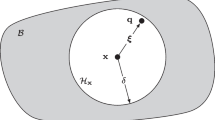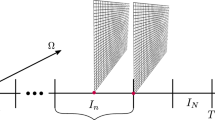Abstract
Adaptive Block FSAI (ABF) is a novel preconditioner which has proved efficient for the parallel solution of symmetric positive definite (SPD) linear systems and eigenproblems. A possible drawback stems from its reduced strong scalability, as the iteration count to converge for a given problem tends to grow with the number of processors used. The preliminary use of graph partitioning techniques can help improve the preconditioner quality and scalability. According to the specific theoretical properties of Block FSAI, different partitionings are selected and tested in a set of matrices arising from SPD engineering applications. The results show that using an appropriate graph partitioning technique with ABF may play an important role to increase the preconditioner efficiency and robustness, allowing for its effective use also in massively parallel simulations.
Similar content being viewed by others
References
Cerdàn, J., Faraj, T., Malla, N., Marin, J., Mas, J.: Block approximate inverse preconditioners for sparse nonsymmetric linear systems. Electron. Trans. Numer. Anal. 37, 23–40 (2010)
Bergamaschi, L., Martinez, A.: FSAI-based parallel Mixed Constraint Preconditioners for saddle point problems arising in geomechanics. J. Comput. Appl. Math. 236, 308–318 (2011)
Lazarov, B.S., Sigmund, O.: Factored parallel preconditioner for the saddle point problem. Int. J. Numer. Methods Biomed. Eng. 27, 1398–1410 (2011)
Ferronato, M., Janna, C., Pini, G.: Parallel solution to ill-conditioned FE geomechanical problems. Int. J. Numer. Anal. Methods Geomech. 36, 422–437 (2012)
Ferronato, M., Janna, C., Pini, G.: Shifted FSAI preconditioners for the efficient parallel solution of non-linear groundwater flow models. Int. J. Numer. Methods Eng. 89, 1707–1719 (2012)
Janna, C., Ferronato, M., Gambolati, G.: Parallel inexact constraint preconditioning for ill-conditioned consolidation problems. Comput. Geosci. 16, 661–675 (2012)
Ferronato, M.: Preconditioning for sparse linear systems at the dawn of the 21st century: history, current developments, and future perspectives. ISRN Appl. Math. (2012). doi:10.5402/2012/127647
Janna, C., Ferronato, M., Gambolati, G.: A Block FSAI-ILU parallel preconditioner for symmetric positive definite linear systems. SIAM J. Sci. Comput. 32, 2468–2484 (2010)
Janna, C., Ferronato, M.: Adaptive pattern research for Block FSAI preconditioning. SIAM J. Sci. Comput. 33, 3357–3380 (2011)
Ferronato, M., Janna, C., Pini, G.: Efficient parallel solution to large size sparse eigenproblems with Block FSAI preconditioning. Numer. Linear Algebra Appl. 19, 797–815 (2012)
Janna, C., Ferronato, M., Gambolati, G.: Enhanced Block FSAI preconditioning using domain decomposition. SIAM J. Sci. Comput. 35, S229–S249 (2013)
Ferronato, M., Janna, C., Pini, G.: A generalized Block FSAI preconditioner for nonsymmetric linear systems. J. Comput. Appl. Math. 256, 230–241 (2014)
Kolotilina, L.Y., Yeremin, A.Y.: Factorized sparse approximate inverse preconditioning. I. Theory. SIAM J. Matrix Anal. Appl. 14, 45–58 (1993)
Benzi, M., Szyld, D.B., Duin, A.: Orderings for incomplete factorization preconditioning of nonsymmetric problems. SIAM J. Sci. Comput. 20, 1652–1670 (1999)
Benzi, M., Tůma, M.: Orderings for factorized sparse approximate inverse preconditioners. SIAM J. Sci. Comput. 21, 1851–1868 (2000)
Cullum, J.K., Johnson, K., Tůma, M.: Effects of problem decomposition (partitioning) on the rate of convergence of parallel numerical algorithms. Numer. Linear Algebra Appl. 10, 445–465 (2003)
Cuthill, E., McKee, J.: Reducing the bandwidth of sparse symmetric matrices. In: Proceedings of the 1969 24th National Conference, pp. 157–172 (1969)
George, A.: Computer Implementation of the Finite Element Method. Tech. Rep. STAN-CS-208. Department of Computer Science, Stanford University, Stanford (1971)
Georges, J.A., Liu, J.W.: Computer Solution of Large Sparse Positive Definite Systems. Prentice-Hall, Englewood Cliffs (1981)
Tinney, W.F., Walker, J.W.: Direct solutions of sparse network equations by optimally ordered triangular factorization. Proc. IEEE 55, 1801–1809 (1967)
George, A., Liu, J.W.: The evolution of the minimum degree ordering algorithm. SIAM Rev. 31, 1–19 (1989)
Amestoy, P., Davis, T., Duff, I.: An approximate minimum degree ordering algorithm. SIAM J. Matrix Anal. Appl. 17, 886–905 (1996)
Barnard, S., Simon, H.D.: A fast multilevel implementation of recursive spectral bisection for partitioning unstructured problems. Concurr Pract Experience 6, 101–117 (1994)
Hendrickson, B., Leland, R.: A multilevel algorithm for partitioning graphs. In: Proceedings of the ACM/IEEE Conference on Supercomputing (1995)
Karypis, G., Kumar, V.: Multilevel k-way partitioning scheme for irregular graphs. J. Parallel Distrib. Comput. 48, 96–129 (1998)
Karypis, G., Kumar, V.: A fast and high quality multilevel scheme for partitioning irregular graphs. SIAM J. Sci. Comput. 20, 359–392 (1999)
Chevalier, C., Pellegrini, F.: Improvement of the efficiency of genetic algorithms for scalable parallel graph partitioning in a multi-level framework. In: Proceedings of EuroPar 2006. Lecture Notes on Computer Science, no. 4128, pp. 243–252 (2006)
Pellegrini, F.: A parallelisable multi-level banded diffusion scheme for computing balanced partitions with smooth boundaries. In: Proceedings of EuroPar 2007. Lecture Notes on Computer Science, no. 4641, pp. 191–200 (2007)
Pellegrini, F.: SCOTCH, software package and libraries for sequential and parallel graph partitioning, static mapping, and sparse matrix block ordering, and sequential mesh and hypergraph partitioning (version 5.1.10). Electronic document available at http://www.labri.fr/perso/pelegrin/scotch (2010)
Karypis, G., Kumar, V.: METIS - A software package for partitioning unstructured graphs, partitioning meshes and computing fill-reducing orderings of sparse matrices - Version 5.0. Electronic document available at http://glaros.dtc.umn.edu/gkhome/metis/metis/overview (2011)
Holland, R.M., Wathen, A.J., Shaw, G.J.: Sparse approximate inverses and target matrices. SIAM J. Sci. Comput. 26, 1000–1011 (2005)
Saad, Y.: ILUT: a dual threshold incomplete ILU factorization. Numer. Linear Algebra Appl. 1, 387–402 (1994)
Li, N., Saad, Y., Chow, E.: Crout version of ILU for general sparse matrices. SIAM J. Sci. Comput. 25, 716–728 (2003)
Janna, C., Comerlati, A., Gambolati, G.: A comparison of projective and direct solvers for finite elements in elastostatics. Adv. Eng. Softw. 40, 675–685 (2009)
Chow, E.: A priori sparsity patterns for parallel sparse approximate inverse preconditioners. SIAM J. Sci. Comput. 21, 1804–1822 (2000)
Grote, M., Huckle, T.: Parallel preconditioning with sparse approximate inverses. SIAM J. Sci. Comput. 18, 838–853 (1997)
Huckle, T.: Approximate sparsity patterns for the inverse of a matrix and preconditioning. Appl. Numer. Math. 30, 291–303 (1999)
Huckle, T.: Factorized sparse approximate inverses for preconditioning. J. Supercomput. 25, 109–117 (2003)
Kaporin, I.E.: New convergence results and preconditioning strategies for the conjugate gradient method. Numer. Linear Algebra Appl. 1, 179–210 (1994)
Anderson, G., Bai, Z., Bischof, C., Demmel, J., Dongarra, J., Du Croz, J., Greenbaum, A., Kenney, A.M., Ostrouchov, S., Sorensen, D.: LAPACK User’s Guide. SIAM, Philadelphia (1992)
Bridson, R., Tang, W.P.: Ordering, anisotropy and factored sparse approximate inverses. SIAM J. Sci. Comput. 21, 867–882 (1999)
Saad, Y.: Iterative Methods for Sparse Linear Systems, 2nd edn. SIAM, Philadelphia (2003)
Saad, Y.: SPARSKIT, a basic tool-kit for sparse matrix computations (Version 2). Electronic document available at http://www-users.cs.umn.edu/~saad/software/SPARSKIT (1988)
Kernighan, B.W., Lin, S.: An efficient heuristic procedure for partitioning graphs. Bell Syst. Technol. J. 49, 291–307 (1970)
Duff, I.S., Kaya, K.: Preconditioners based on strong subgraphs. Electron. Trans. Numer. Anal. 40, 225–249 (2013)
Vecharinsky, E., Saad, Y., Sosonika, M.: Graph partitioning using matrix values for preconditioning symmetric positive definite systems. SIAM J. Sci. Comput. 36, A63–A87 (2014)
Teatini, P., Ferronato, M., Gambolati, G., Baù, D., Putti, M.: Anthropogenic Venice uplift by seawater pumping into a heterogeneous aquifer system. Water Resour. Res. 46, W11547 (2010). doi:10.1029/2010WR009161
Ferronato, M., Gambolati, G., Janna, C., Teatini, P.: Geomechanical issues of anthropogenic CO2 sequestration in exploited gas fields. Energy Convers. Manag. 51, 1918–1928 (2010)
Davis, T.A., Hu, Y.: The University of Florida Sparse Matrix Collection. ACM Trans. Math. Softw. 38, 1–25 (2011)
Author information
Authors and Affiliations
Corresponding author
Rights and permissions
About this article
Cite this article
Janna, C., Castelletto, N. & Ferronato, M. The effect of graph partitioning techniques on parallel Block FSAI preconditioning: a computational study. Numer Algor 68, 813–836 (2015). https://doi.org/10.1007/s11075-014-9873-5
Received:
Accepted:
Published:
Issue Date:
DOI: https://doi.org/10.1007/s11075-014-9873-5




